Open air carbon monoxide poisoning is under-recognized. In this article Dr Andrew discusses the hazards associated with CO poisoning due to boat exhaust.
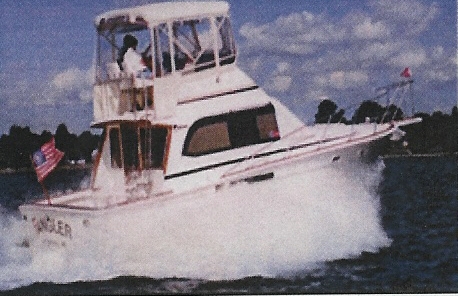
Carbon monoxide poisoning typically occurs from breathing air contaminated by carbon monoxide (CO). Symptoms are often described as “flu-like” and commonly include headache, dizziness, weakness, vomiting, chest pain, and confusion. Large exposures can result in loss of consciousness, arrhythmias, seizures, or death.
Carboxyhemoglobin (COHgb) is a stable complex of carbon monoxide and hemoglobin that forms in red blood cells when carbon monoxide is inhaled.
Relative CO Concentrations
| CO Exposure Concentration (ppm) |
Relevant exposure limit or outcome |
| 26 |
WHO limit for 1-hour exposure |
| 87 |
WHO limit for 15-minute exposure |
| 200 |
NIOSH workplace ceiling limit |
| 1,200 |
Immediate danger to life & health |
| 6,400 |
Danger of death in 10-15 minutes |
| 12,800 |
Danger of death in 1-3 minutes |
Typically, carbon monoxide poisoning is associated with closed environment and insufficiently vented generators, vehicles or other sources of products of combustion, however even in the open localized concentrations of CO can reach lethal levels. In particular, exposure to the exhaust from motorized boats can be hazardous.
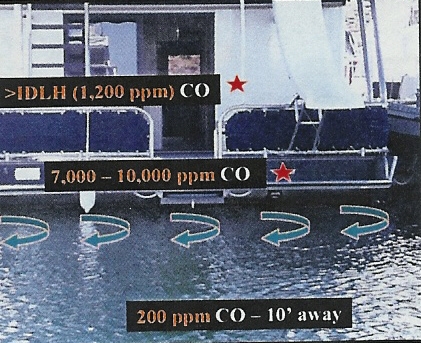
A COHgb test should be considered in every death occurring on or near a motorized boat. We only see what we look for and we only look for what we know.
Case Report – Otisco Lake 1996
A 16-year-old female was swimming off the stern of a motor boat with a propulsion engine running to warm the water. After 10 minutes, she was observed by companion to “slip away.”
A 911 Call was made by a companion who stated that he “needed to get off the phone to breath.”. Three other youths at the bow of the boat were all without symptoms.
An underwater search recovered the body five days later at a depth of fifty feet
Water temperature 48o F, the following results were observed during the autopsy.
- Well preserved, no decomposition
- Full rigor, pink livor
- No trauma
- Pulmonary congestion and edema (1490 gm, combined)
- Pink discoloration of brain
- No internal evidence of blunt trauma
Toxicology
- Negative for drugs of abuse
- Trivial alcohol
- COHgb 62% in heart blood
- COHgb 51% in femoral blood
- COHgb tested twice in two different labs
Scene Investigation
- Open bow motor boat
- 1981 Crestliner, 17-foot pleasure craft
- Inboard/outboard engine
- Traveled 450 yards to center of fresh water lake
Scene Investigation – CO testing
- After idling 8 minutes CO >100 ppm in air several inches above water level at stern
- Largest concentration at stern just above water surface and at transom
- Lower concentrations when accelerator depressed
- No significant accumulation at driver’s or front passenger’s seats
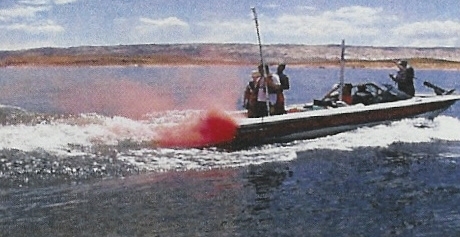
Lessons Learned
- CO poisoning may be overlooked in the setting of motor use on open water
- Not all bodies in water have drowned
- CO may be causative or contributory via incapacitation
- Consider COHgb testing whenever potential exhaust exposure has occurred
- Toxic levels can accrue even in open air environments
- Boaters preoccupied with recreation may misattribute headache, etc. to seasickness or sun exposure
Boat-related CO Poisonings Nationwide 1990-2015
(Source: US Coast Guard Recreational Boating Statistics):
- 872 reported poisonings
- 174 fatalities
Where CO exposure can occur:
- In the water
- On the deck
- Generators
- Propulsion engines
- Stationary ski boats
- Showers in a toxic environment
- In rear seats
- On the transom
- Moving ski boats
- Cabin cruiser generators
- Open water and shore areas with a high density of boats
For example, a houseboat generator presents significant risks both on the water and on the deck. CO concentrations as high 85,000 ppm have been observed where the exhaust leaves the boat
House Boat Generator Fatalities Observed
- 57-year-old exposed for “minutes” diving to free the anchor – COHgb 22% (analysis 18 months after autopsy)
- 64-year-old exposed less than 20 minutes cleaning the scum line – COHgb 62%
- Fatality: 12-year-old exposed for 30 minutes, “disappeared” from the platform – COHgb 54%
The “Death Zone”
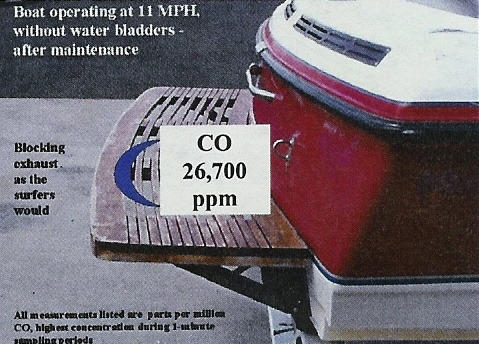
The area beneath the swim platform is where the exhaust from the generators and propulsion engines is typically expelled.
A typical propulsion engine generates 60,000 to 80,000 ppm CO in the air when operating. The generator can add CO at 30,000 ppm in the air.
Example Fatalities
- Two brothers sank from the airspace under a houseboat after approximately 3 minutes of exposure to generator exhaust.
- Adults entering airspace just after deactivating engines
- COHgb 55% after several entries
- COHgb 49% after 5-10 minutes exposure
- COHgb 72% after 5 minutes exposure
Stationary Ski Boats when idling – example cases
- Non-fatal – 2-year-old with loss of consciousness, exposed for ~one minute”, COHgb 14% after 2.5 hours of hyperbaric oxygen (extrapolates back to a level of 50-75%)
- Fatal – 62-year-old died sitting on the platform, COHgb 89%
Showers in a toxic environment
Taking a shower using the water warmed by engine can be hazardous. This might be done to preheat your wetsuit, warm up after a cool swim or wash sand and dirt from your feet and decks. In these instances, one must be on the swim platform while the engines are running.
Moving Ski Boats, risks in rear seat or on the transom – Teak surfing.
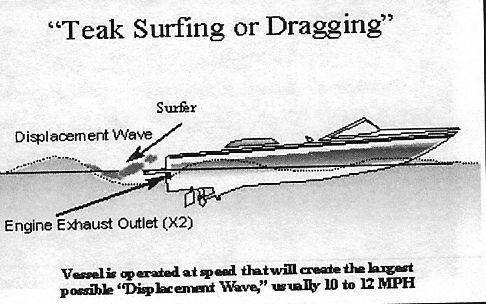 “Teak surfing”
“Teak surfing” or dragging is an activity where people hang off the back of the boat while it is moving and are dragged through the water.
CO levels have been observed as high as 26,700 ppm on a boat operating at 11 mph, without water bladders – after maintenance.
In one fatal case, an 18-year-old male sank and drowned after five minutes of teak surfing – COHgb 57%
Case Report – Cabin Cruiser Generators
Two 9-year-old girls were, playing near the generator, exhaust for 10 minutes.
One did not respond to a call for lunch – COHgb 15% – recovered after 71 minutes of 100% O2.
30 minutes after the first girl was found, the 2nd girl was found at the lake bottom – COHgb 39%
Scene Investigation CO measurements:
- 41,600 ppm at exhaust terminus
- >2000 ppm 5 feet away from exhaust terminus
- 570 ppm 10 feet away from exhaust terminus
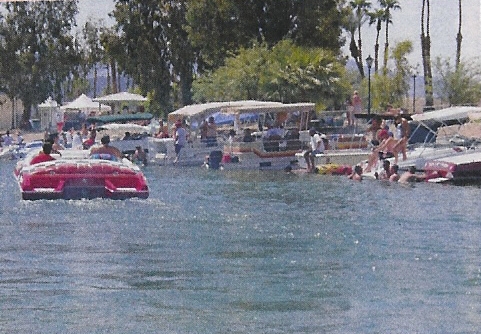
Case Report: High Density of Boats – Lake Havasu, Memorial Day, 2003
City employees
- 67% of inspired CO tests in non-smokers exceeded recommended limits
- Air sampling confirmed CO overexposure during each monitoring period
Visitors
- 4 presented with loss of consciousness – COHgb 19%-47%
- One drowning, wading near boats in the channel – COHgb 47%
- Avg. COHgb rose in non-smokers from 1% to 13% from morning to late afternoon with highest being 23% and 26%
- Highest ambient CO concentrations occurred in late afternoon/early evening (5-9 PM), when wind speeds typically decreased.
How long does Carboxyhemoglobin (COHgb) remain?
Carboxyhemoglobin is a stable complex of carbon monoxide and hemoglobin (Hb) that forms in red blood cells upon contact with carbon monoxide (CO). It hinders the ability of hemoglobin to deliver oxygen to the body.
- Time varies widely by individual
- In air: 2 – 6 hours
- Treated with oxygen: 1 hour
- Treated with hyperbaric oxygen: 20 minutes
Prevention
- The most important factor is AWARENESS
- Improved emission controls by boat manufacturers
- Limiting number of boats in channels and other close areas
- Enforced “no idle” policy on stationary boats
- Boater education
- Signs and symptoms of CO poisoning
- Hazards related to occupying the back of the boat any time the motor is running
- Risk for CO poisoning in areas of boat congestion, especially during calm weather conditions
- More information may be found at cdc.gov
 Carbon monoxide poisoning typically occurs from breathing air contaminated by carbon monoxide (CO). Symptoms are often described as “flu-like” and commonly include headache, dizziness, weakness, vomiting, chest pain, and confusion. Large exposures can result in loss of consciousness, arrhythmias, seizures, or death.
Carboxyhemoglobin (COHgb) is a stable complex of carbon monoxide and hemoglobin that forms in red blood cells when carbon monoxide is inhaled.
Carbon monoxide poisoning typically occurs from breathing air contaminated by carbon monoxide (CO). Symptoms are often described as “flu-like” and commonly include headache, dizziness, weakness, vomiting, chest pain, and confusion. Large exposures can result in loss of consciousness, arrhythmias, seizures, or death.
Carboxyhemoglobin (COHgb) is a stable complex of carbon monoxide and hemoglobin that forms in red blood cells when carbon monoxide is inhaled.
 A COHgb test should be considered in every death occurring on or near a motorized boat. We only see what we look for and we only look for what we know.
A COHgb test should be considered in every death occurring on or near a motorized boat. We only see what we look for and we only look for what we know.

 The area beneath the swim platform is where the exhaust from the generators and propulsion engines is typically expelled.
A typical propulsion engine generates 60,000 to 80,000 ppm CO in the air when operating. The generator can add CO at 30,000 ppm in the air.
The area beneath the swim platform is where the exhaust from the generators and propulsion engines is typically expelled.
A typical propulsion engine generates 60,000 to 80,000 ppm CO in the air when operating. The generator can add CO at 30,000 ppm in the air.
 “Teak surfing” or dragging is an activity where people hang off the back of the boat while it is moving and are dragged through the water.
CO levels have been observed as high as 26,700 ppm on a boat operating at 11 mph, without water bladders – after maintenance.
In one fatal case, an 18-year-old male sank and drowned after five minutes of teak surfing – COHgb 57%
“Teak surfing” or dragging is an activity where people hang off the back of the boat while it is moving and are dragged through the water.
CO levels have been observed as high as 26,700 ppm on a boat operating at 11 mph, without water bladders – after maintenance.
In one fatal case, an 18-year-old male sank and drowned after five minutes of teak surfing – COHgb 57%


